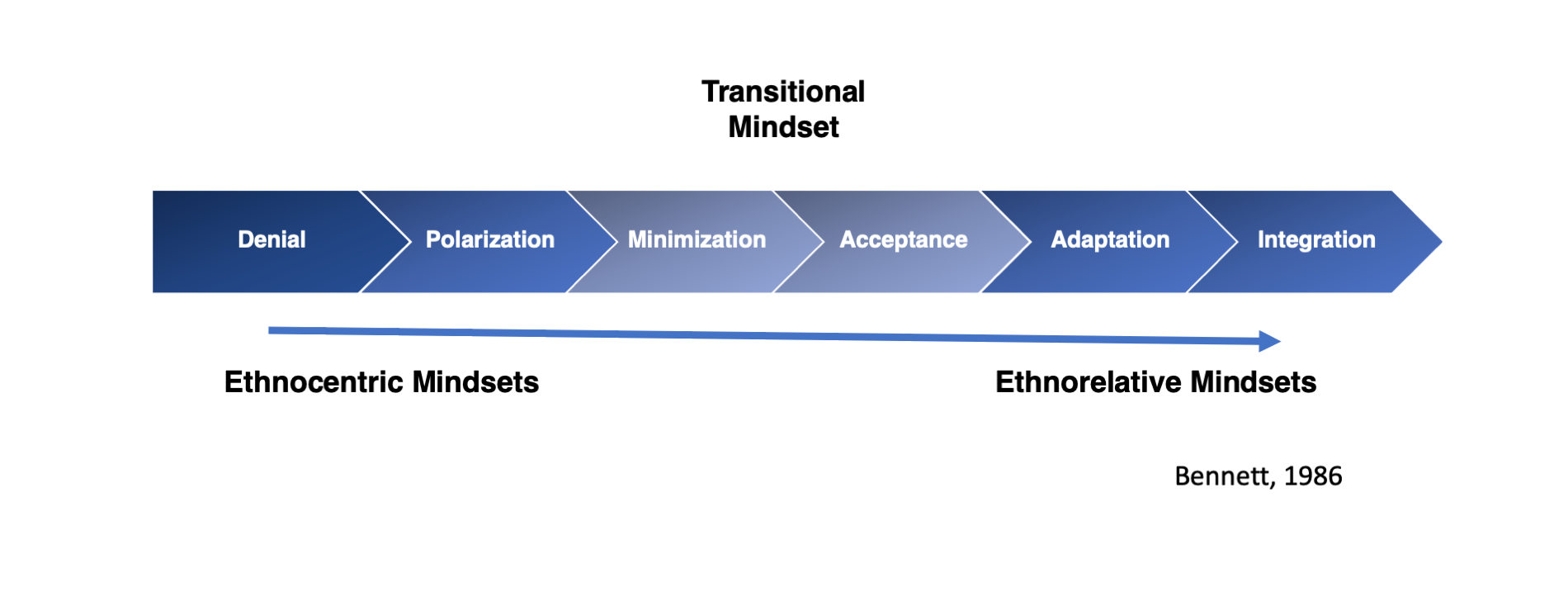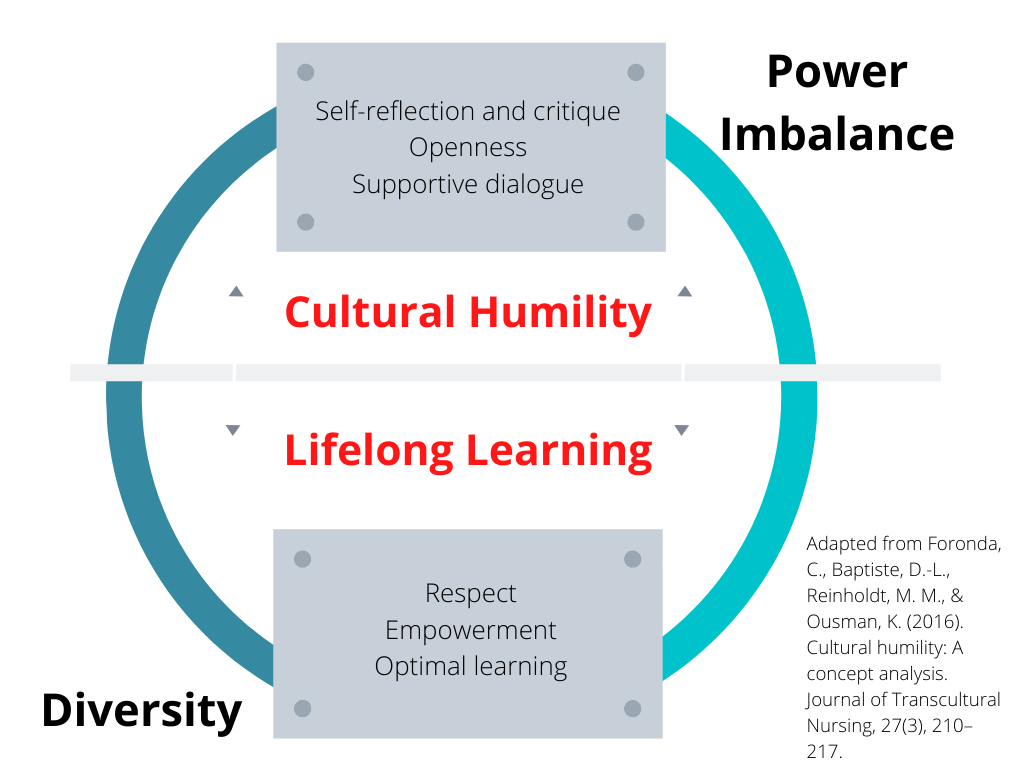4 Pathways of Intercultural Development
Becoming an effective intercultural educator involves embarking on a journey of personal and professional intercultural development. Commonly, this journey is framed as developing intercultural competence. Definitions of intercultural competence vary, however, commonalities include a focus on growth in knowledge, skills, and attitudes that support acceptance of “diverse diversities”, and the ability to act effectively in intercultural contexts (Deardorff, 2006; Spitzberg & Chagnon, 2009). Hundreds of models of intercultural competence exist; however, the idea of interculturality as an achievable competence itself can be challenged for failing to account for lifelong development, promoting a model of “success” that stigmatizes conflict and errors, and ignoring the fact that effective interculturality occurs in a relational context, where the perspectives of all parties must be considered (Dervin 2016; Tervalon & Murray-Garcia, 1998).
The challenges of defining effective interculturality are vast, and provide another occasion to move through “simplexity” in search of working definitions and models that can provide guidance for the journey. In this chapter, we explore two ways of understanding intercultural development: The Developmental Model of Intercultural Sensitivity (Bennett, 1986) and Cultural Humility (Tervalon & Murray-Garcia, 1998).
The Developmental Model of Intercultural Sensitivity
The Developmental Model of Intercultural Sensitivity (DMIS) (Bennett, 1986) presents growth in interculturality as a developmental process with six stages, encompassing a movement from a monocultural mindset to an intercultural mindset. The model proposes that individuals generally move through a trajectory of increased understanding of cultural similarity and difference that moves from a position of viewing differences from a judgemental lens to the ability to negotiate similarities and differences without judgement, while adapting one’s behaviour appropriately to the cultural context.
 Characteristics of Intercultural Mindsets
Characteristics of Intercultural Mindsets
Each mindset is associated with key characteristic styles of thinking and behaving, as described in the chart below.
| Denial | Polarization | Minimization | Acceptance | Adaptation | Integration |
| Unawareness of or inability to recognize cultural difference | Viewing cultural difference in binary terms, “us and them”, stereotyping | Addressing cultural difference with a focus on similarity and commonality | Acceptance of both behavioural differences and different ways of perceiving the world | Shifting behaviour and thinking appropriately in response to cultural difference | The ability to apply ethnorelativism to one’s own cultural identity, the ability to be both integrated with and separate from a cultural context |
Evaluation of the DMIS
The DMIS model positively contributes to understandings of intercultural development by outlining a typical trajectory that growth in interculturality can take, identifying the desirability of moving forward in the journey, and normalizing the developmental path of intercultural growth. The model informs the Intercultural Development Inventory (IDI) that has been used internationally in a variety of contexts to assist individuals in identifying their current stage of intercultural development, and identifying concrete ways to move ahead.
The weakness of the DMIS is its potential to oversimplify the process of intercultural development, suggesting that interculturality always develops in a linear, forward fashion. This can lead to a focus on achieving “competence”, rather than the acknowledgment that interculturality is a lifelong journey that includes both successes and failures. Like many other models of intercultural development, it also locates interculturality within the individual, rather than within the relational context where interaction takes place.
With these limitations in mind, the DMIS model provides a generally useful description of a pathway to more effective intercultural engagement. Its limitations can be addressed by setting it alongside models that more explicitly address the interpersonal and lifelong dimensions of interculturality.
Cultural Humility
The cultural humility model, first proposed by Tervalon and Murray-Garcia (1998), attempts to frame intercultural development in a way that acknowledges the inherent limitations of competence-based models. Foronda et al. (2016) define cultural humility as, “a process of openness, self-awareness, being egoless, and incorporating self-reflection and critique after willingly interacting with diverse individuals. The results of achieving cultural humility are mutual empowerment, respect, partnerships, optimal care, and lifelong learning” (p. 213).

Discussions of cultural humility as a framework for professionals who engage interculturally are most frequent in the social work, health sciences, and counselling psychology literature; however, the model has much to offer educators.
Cultural humility places a strong emphasis on personal development, and growth in attributes such as openness to others and genuine curiosity about their lived experiences. It also emphasizes self-reflection, a foundational aspect to integrating experience in a way that leads to genuine personal growth. The model is also strong in its presentation of interculturality as a dialogic process that takes place in the context of relationships. There is no emphasis within the model on gaining general knowledge about cultures. Cultural humility emphasizes the understanding that forms within genuine intercultural dialogue with unique individuals.
Another strength of the cultural humility model is its acknowledgement of the reality of power relationships and the ways that these may shape the intercultural encounter. These power relationships may be shaped by the societal inequalities of dominant and non-dominant cultures. In professional contexts, they are also shaped by the power of the professional in the intercultural encounter. In educational contexts, cultural humility urges an examination of the ways in which our educator roles create a power imbalance with students that influences the nature of the intercultural relationship. Accounting for these power imbalances is a vital first step in a movement towards relational equality.
Finally, cultural humility acknowledges that interculturality is a lifelong journey, with no set endpoint or final achievement. This integrates with Dervin’s (2016) suggestions on how intercultural development is viewed within the liquid (realistic) understanding of culture and interculturality. Dervin suggests that those who embark on the intercultural development journey must be prepared to embrace pain and learn from failure, rather than expecting to move through a trajectory of continual success. The liquid (realistic) model of intercultural development, like cultural humility, acknowledges that intercultural encounters always involve more than one party, and the success or failure of the encounter lives within a jointly negotiated space.
Intercultural Development as Transformative Learning
As we interpret the world, we are limited by our frames of reference. These frames of reference are shaped by our life experiences and prior learning, and form an interpretive grid through which we interpret other events and interactions in our lives. The process of lifelong learning involves critical dialogue that shifts our habits of mind in ways that allow us to incorporate new meaning schemes, and so think and respond with changed habits of mind and enlarged frames of reference (Mezirow, 1997). Through this process, we engage in transformative learning.
Transformative learning is often motivated by “disorienting dilemmas”, where our previous practices become ineffective (Cranton, 1996). For many educators, entering intercultural teaching practice creates these dilemmas, when we face contexts in which formerly effective ways of teaching no longer serve the needs of our current students. The recognition of this dilemma motivates a change process, which begins with critical dialogue and reflection on beliefs and practices.
Mezirow (1991) contrasts three types of reflection: content reflection, process reflection, and premise reflection. In content reflection, the focus of reflection is on the problem itself, and the strategies used to solve it. Process reflection interrogates whether the strategies used to solve the problem are well-chosen and effective. Premise reflection moves away from a problem solving mindset, and questions underlying values, beliefs, and assumptions. Premise reflection holds the greatest potential for transformation (Cranton, 1996). Intercultural teaching development creates opportunities for this type of reflection, as we interrogate the sources of our own beliefs and assumptions about teaching, and begin to imagine other possibilities outside of our previous frames of reference. A transformative approach to intercultural development holds that critical reflection is an essential part of the process of intercultural development.
The transformative learning that best supports intercultural development occurs in the context of supportive peer relationships. Taylor (2007) writes that “it is through trustful relationships that allow individuals to have questioning discussions, share information openly and achieve mutual and consensual understanding” (p. 179). As Taylor emphasizes, the role of peer support is to create the conditions that generate the courage required for challenging previous assumptions and stepping into ways of thinking about the world. For example, growth in anti-racism for white educators requires recognition of the unconscious habits of mind fostered through socialization in a culture where white supremacist schemas of thought are present, critical dialogue to confront old habits of mind, and supportive challenge to enter new habits of mind (European-American Collaborative Challenging Whiteness, 2007). This challenge is best faced in the context of a supportive peer learning community.
In summary, through a transformative perspective, we enter the process of intercultural learning and development with the knowledge that we will be challenged to shift old ways of seeing the world, and to form new habits of mind that shift our thinking and responses. As Cranton (1996) highlights, this form of learning is emancipatory, as we become freed from previous constraints and can explore new ways of understanding and being. Transformative learning is achieved through critical dialogue, in the context of ongoing personal reflection, in the context of a supportive learning community.
References
Bennett, M. J. (1986). A developmental approach to training for intercultural sensitivity. International Journal of Intercultural Relations, 10(2), 179–196. https://doi.org/10.1016/0147-1767(86)90005-2
Cranton, P. (1996). Professional development as transformative learning: New perspectives for teachers of adults (1st ed). Jossey-Bass Publishers.
Deardorff, D. K. (2006). Identification and assessment of intercultural competence as a student outcome of internationalization. Journal of Studies in International Education, 10(3), 241–266. https://doi.org/10.1177/1028315306287002
Dervin, F. (2016). Interculturality in education: A theoretical and methodological toolbox. Palgrave Macmillan.
Foronda, C., Baptiste, D.-L., Reinholdt, M. M., & Ousman, K. (2016). Cultural humility: A concept analysis. Journal of Transcultural Nursing, 27(3), 210–217. https://doi.org/10.1177/1043659615592677
Mezirow, J. (1991). Transformative dimensions of adult learning (1st ed). Jossey-Bass.
Mezirow, J. (1997). Transformative learning: Theory to practice. New Directions for Adult and Continuing Education, 1997(74), 5–12. https://doi.org/10.1002/ace.7401
Spitzberg, B. H., & Changnon, G. (2009). Conceptualizing intercultural competence. In D. K. Deardorff (Ed.), The Sage handbook of intercultural competence (pp. 2–52). Sage Publications.
Taylor, E. W. (2007). An update of transformative learning theory: A critical review of the empirical research (1999–2005). International Journal of Lifelong Education, 26(2), 173–191. https://doi.org/10.1080/02601370701219475
Tervalon, M., & Murray-García, J. (1998). Cultural humility versus cultural competence: A critical distinction in defining physician training outcomes in multicultural education. Journal of Health Care for the Poor and Underserved, 9(2), 117–125. https://doi.org/10.1353/hpu.2010.0233

